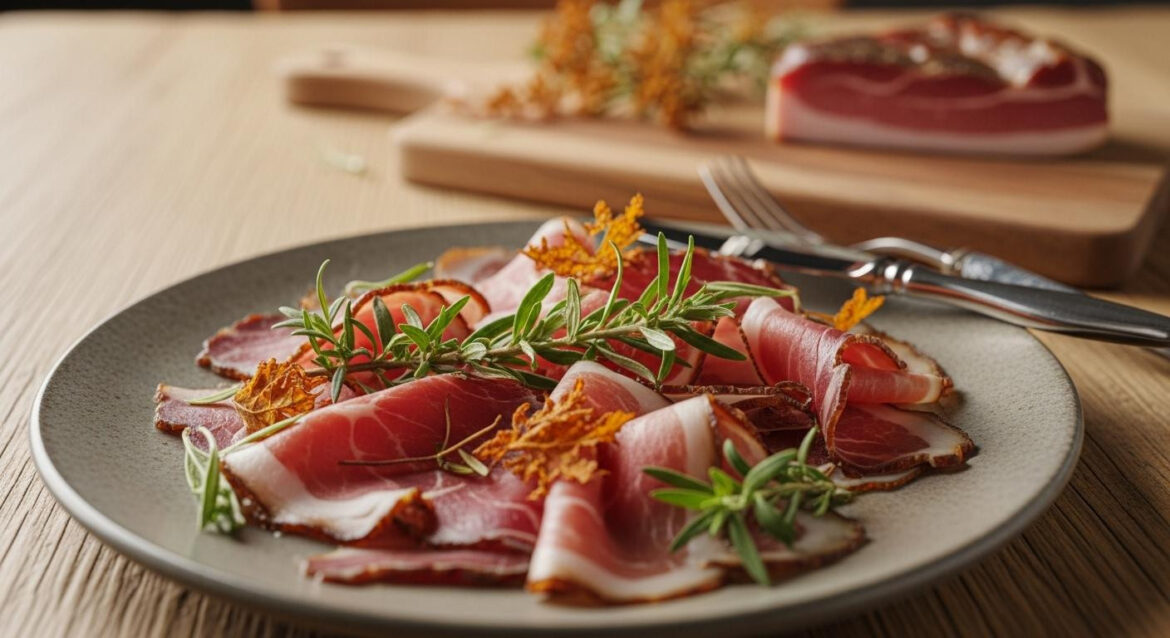Dawn breaks at 6:47 AM over Val Gardena as steam rises from espresso cups at a wooden chalet where only 28 guests will dine tonight. Through floor-to-ceiling windows, the Dolomites glow pink-gold in October light. A Michelin-starred chef arranges Speck from a 200-year-old smokehouse beside foraged alpine herbs. Three days ago, you knew Italian dining meant crowded trattorias. Now, this intimate chalet reveals what 3 million annual Dolomites visitors miss entirely.
Where Alpine tradition meets Michelin innovation
South Tyrol hosts Italy’s highest concentration of Michelin stars, with 6 stars scattered across just 15 square kilometers in Alta Badia alone. Traditional wooden chalets have transformed into intimate dining venues, preserving their centuries-old larch beam construction while housing cutting-edge kitchens. October through November offers the secret season when chefs have time for extended conversations with guests.
The unique Ladin cultural heritage defines every dish. This ancient Romance language community has preserved culinary traditions for over 500 years. Chef-driven restaurants like La Siriola and La Stüa de Michil reinterpret these mountain recipes with modern techniques. These autumn retreats showcase similar heritage preservation through food.
The Ladin culinary heritage tourists never taste
While resort restaurants serve generic alpine fare, these chalets source from producers whose families have operated for centuries. Speck smokehouse owners cure ham the same way since 1782, using beechwood smoke for 21 days followed by 6-month aging. Michelin chefs transform humble Schlutzkrapfen (buckwheat pasta pockets) and Knödel (bread dumplings) into refined presentations.
From Speck smokehouses to Michelin plates
The Alpine-Mediterranean fusion unique to this region reflects ancient trade routes through mountain passes. Local producers supply 90% of ingredients within 19 miles. Traditional Schlutzkrapfen differ from Italian ravioli through thicker buckwheat dough and spinach-ricotta filling served with crispy onions.
The chalet architecture of intimate dining
Handcrafted wooden interiors feature centuries-old larch beams and stone fireplaces. Maximum capacity rarely exceeds 32 covers, creating exclusivity impossible in larger venues. The contrast between rustic warmth and culinary sophistication defines the experience. Dining rooms overlook dramatic limestone peaks through traditional flower-box windows.
Inside a private Michelin dinner experience
The typical evening begins at 7 PM with foraged appetizers featuring mountain herbs and local cheese. Five-course tasting menus progress from delicate Speck preparations to game meats like venison and chamois. Alto Adige wine pairings complement each dish. Chefs personally explain ingredient origins and preparation methods.
The five-course mountain journey
Each course tells a story of the mountains. Appetizers might feature foraged mushrooms and mountain truffles. Main courses showcase local game prepared with traditional smoking techniques. Similar transformative experiences emphasize how food rituals connect travelers to local culture.
Beyond the plate: the Ladin dining philosophy
Meals last over 3 hours, reflecting the Ladin tradition of unhurried dining. Seasonality drives every menu, with autumn bringing game, wild mushrooms, and late-harvest apples. Chefs maintain personal relationships with farmers and foragers. Traditional serving customs include the “Cunfin” bread ritual welcoming guests.
What makes this different from resort dining
The silence of 28 guests contrasts sharply with 200-seat resort restaurants. Chefs remember your preferences and dietary needs. You can visit the smokehouse or meet the cheese maker. October’s special intimacy occurs when ski crowds haven’t arrived but weather remains perfect at 41-54°F. Exclusive properties worldwide share this intimate, locally-valued approach.
The personal attention extends beyond service. Chefs share family recipes and explain why certain ingredients only grow at specific altitudes. This level of engagement disappears in larger establishments. The surrounding alpine meadows and limestone spires visible from every table amplify the sense of dining within nature itself.
Your questions about Dolomites Michelin chalet dining answered
How much does a private Michelin chalet experience actually cost?
Accommodation ranges from $440 per night for luxury chalets with private dining access. Tasting menus cost $140-275 per person depending on wine pairings. This compares favorably to Swiss Alps venues ($320+ per person) or French Alps equivalents (30% more expensive). October-November bookings save 25% compared to peak winter season.
What makes Ladin cuisine different from standard Italian food?
Ladin cuisine blends Tyrolean and Italian Alpine traditions with Germanic influences. Schlutzkrapfen use buckwheat flour instead of wheat, creating heartier textures. Smoking and preservation techniques reflect harsh mountain winters. The cuisine emphasizes local game, alpine dairy, and foraged ingredients unavailable in lowland Italian cooking.
Which Dolomites valley offers the most authentic chalet dining?
Val Gardena preserves the highest level of Ladin cultural authenticity, with Suinsom offering 24-seat intimacy. Alta Badia concentrates the most Michelin stars (6 total) with La Siriola leading innovation. Italian destinations throughout the country reward November timing with ideal conditions and fewer crowds.
The fireplace crackles softly as your final course arrives: apple strudel reimagined with mountain pine essence and local honey. Outside, the first stars appear above limestone peaks bathed in alpenglow. This isn’t dinner but the moment you understand why 110,000 South Tyroleans have protected this culinary heritage for centuries, sharing it only with those who truly seek it.


Dining and Cooking